Research
Productivity of American Oystercatchers

Investigator(s): Abby Powell, Janell Brush
Student(s): Nicholas Vitale, MS, Wildlife Ecology and Conservation
Duration: September 2016-June 2020
Spoil islands created as part of the Cross Florida Barge Canal project support breeding American Oystercatchers. However, annual site productivity is low (average of 0.05 chicks per pair) compared to annual statewide productivity during the same time period (average >0.20 chicks per pair). We need to understand what is limiting breeding productivity for the oystercatcher population breeding along the Nature Coast. Determining the effects of disturbance from humans and predators on oystercatcher productivity on the CFG spoil islands will better focus conservation efforts in the area. We will propose management actions to increase annual productivity of oystercatchers nesting on spoil islands in the Cross Florida Greenway State Recreation and Conservation Area.
Habitat Use and Population Dynamic of Juvenile Green Turtles (Chelonia mydas) and Kemp's Ridleys (Lepidochelys kempii) Along Florida's Nature Coast

Investigator(s): Ray Carthy
Student(s): Rick Herren, PhD, Wildlife Ecology & Conservation
Duration: September 2016 - June 2020
Florida's Nature Coast is relatively undeveloped and contains the second largest seagrass ecosystem in the Gulf of Mexico. Thousands of acres of shallow seagrass beds and hard-bottom are potential foraging habitats for juvenile green and Kemp's ridleys turtles. Little research has been done in this area since Dr. Archie Carr and colleagues first described the Cedar Key turtle fishery in the 1950s. The goal of this project is to characterize the habitat use and population dynamics of sea turtles foraging in this region. We plan to carry out broad scale vessel and UAV (Unmanned Aerial Vehicle) surveys in nearshore habitats to determine sea turtle occupancy and abundance "hotspots" and coupling those with measurements of environmental and benthic co-factors such as the availability of food and shelter. Our design includes multi-variate occupancy models, which will help us answer questions such as why turtles are present in some areas and not in others even when the habitat might appear to be similar. This research will also help elucidate trends in habitat use over seasons and years. At the same time, we will also be establishing long-term capture-mark-recapture sites to measure demographics, disease rates, diet and sex ratios in an effort to characterize the population of turtles in these areas.
A Nutritional Ecology Study of Dermatemys mawii, a Critically Endangered Species of Freshwater Turtle Endemic to Central America

Investigator(s): Nichole Bishop, Karen Bjorndal, & Ray Carthy
Student(s): Nichole Bishop, School of Natural Resources and Environment
Duration: December 2014 - 2018
Dermatemys mawii is a critically endangered fresh-water turtle endemic to Central America. Captive breeding programs have been identified as an important component of conservation efforts for D. mawii, but relatively little is known about their biology and ecology. Diet is a primary means by which an organism interacts with its environment and is essential in understanding an organism's ecology. We are using a nutritional ecology framework to examine D. mawii's digestive physiology, gut morphology and microbial endosymbiont community in an effort to elucidate their dietary adaptations and subsequent implications for captive and wild management. The objectives are to: 1) describe and quantify the natural diet composition of D. mawii; 2) describe and compare age-specific differences in the digestive performance of D. mawii between yearlings and adults; 3)describe and compare the gut morphology and allometrics of D. mawii among hatchlings, juveniles and adults; and 4) characterize the gut microflora of D. mawii hatchlings, juveniles, and adults.
The Path Most Travelled: Leatherback and Cheloniid Sea Turtle Migration Movements and Foraging Areas

Investigator(s): Daniel Evans, Ray Carthy
Student(s): Daniel R Evans, PhD, Wildlife Ecology and Conservation
Duration: January 2014-December 2017
Movement between habitats is vital to the survival of marine turtles. Foraging in the marine environment is difficult by patchiness of food, often due to the interaction of oceanic features and currents. Marine turtles are searching for food, pursuing food, or moving to another area that might contain more food. To reduce migration energy costs, sea turtle foraging areas need to be predictable and persistent over time. By connecting oceanic features, currents, geomagnetic fields, and animal movements, it is possible to identify factors influencing feeding areas and migration pathways in the seascape for different species of sea turtles.
Research objectives are 1) to identify ocean features that characterize foraging areas used by female leatherback sea turtles to see if these areas are geographically stable, 2) to model the migration movements of leatherback, green, loggerhead, and hawksbill sea turtles, and 3) to compare identified sea turtle foraging areas and migration pathways to known Marine Protected Areas.
Standardized Measurements of Loggerhead Sea Turtle Hatchling Orientation: Quantifying Effects of Artificial Light and Light Mitigation Programs

Investigator(s): Shigetomo Hirama, Robert Hardy, Morgan Young, Ray Carthy, and Blair Witherington
Student(s): Shigetomo Hirama, MS, Wildlife Ecology and Conservation
Duration: 2015-present
Artificial lighting disorients sea turtle hatchlings and reduces their chances of survival. The recovery plan for northwest Atlantic loggerhead sea turtles lists light pollution among the most important mortality factors. Light management as a means of reducing that mortality is under way, but there are no reliable measures for assessing progress and effectively guiding management. The current project provides information on sea turtle hatchling orientation on the Florida beaches along the Gulf of Mexico and Atlantic Ocean. Standardized measurements will be used to map the severity of disorientation caused by artificial lighting. The results will directly inform management agencies to reduce artificial lighting so that the number of hatchlings that enter the ocean can be increased.
Project objectives are to collect data on light intensity and hatchling orientation and to identify the degree of disorientation such that spatial and temporal trends may be assessed. Detail in hatchling orientation measurement would inform beach lighting management strategies for reducing disorientation of hatchlings.
The Long-term Spatiotemporal Patterns, Nesting Success and Hatching Success of Marine Turtles on an Undeveloped Beach in Northeast Florida
Investigator(s): Scott Eastman, Todd Osborne, Raymond Carthy
Student(s): Scott Eastman, MS, School of Natural Resources and the Environment
Duration: September 2014-December 2017
Sea level rise, increasing rates of coastal erosion, and the current coastal management response of coastal armoring is resulting in large stretches of seawalls being constructed in northeast Florida. The rate and extent of the coastline that is armored, and the effect this is having on the availability of suitable areas for nesting sea turtles is relatively unknown. The current paradigm in coastal management is focused on protection of property though coastal armoring. Roughly 25 percent of Florida's coastal shorelines were recorded as being armored in 1998. These trends in coastal armoring and the effects on sea turtles and their nesting habitats have yet to be fully understood. Our research objectives will take multiple approaches in identifying descriptive and causal inference for the effects of coastal armoring on available sea turtle nesting habitat and reproductive behaviors: a descriptive approach identifying the spatiotemporal trends in the availability of habitat due to coastal armoring, and a comparative model of sea turtle nesting behaviors and reproductive success associated with natural beaches and armored shorelines. The current management responses to rising seas and coastal erosion make understanding coastal armoring effects on the availability of suitable areas for nesting sea turtles and impacts to nesting behaviors critical for adaptive management practices, and can provide critical inputs to compliment a holistic framework for decision-making, ultimately resulting in greater species protection.
Effects of Coastal Dynamics and Climate on Loggerhead Turtle Nest Success and Management: An Assessment of Sea Turtle Nesting Beaches in St. John's County Florida
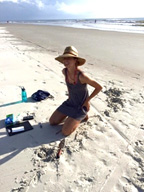
Investigator(s): Raymond Carthy
Student(s): Nichole Bishop, MS, School of Natural Resources and the Environment
Duration: December 2014-July 2018
St. John's county beaches are popular nesting sites for green turtles (Chelonia mydas), loggerheads (Caretta caretta) and leatherback turtles (Dermachelys coriacea); these same beaches are also popular destinations for people and range in development from dense residential properties to protected, undeveloped reserve. Beach slope is an important factor in sea turtle nesting preference and is a result of multiple factors including erosion and accretion catalyzed by human activities. Baseline monitoring is necessary to establish changes to beach morphodynamics given their varied anthropogenic usage, potential impacts from climate change and most recently, Hurricane Matthew of October 2016. Our objectives are to characterize the Guana Tolomato Matanzas National Estuarine Research Reserve (GTMNERR) beach, Crescent Beach and the Archie Carr beach property in Summer Haven by: 1) monitoring beach slope, 2) measuring sand grain size and 3) surveying flora.
Doris Duke Scholars Program
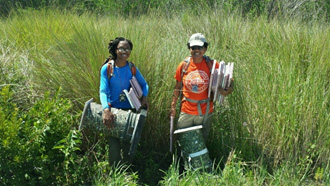
Investigator(s): Ray Carthy, Christina Romagosa, Rena Borkhataria
Student(s): Nichole Bishop, Wes Boone, Brian Smith
Duration: September 2013 - September 2019
The annual goals of the Doris Duke Conservation Scholars Program include providing students with a better understanding of the research process, exposing them to a variety of research and field techniques, and helping to develop a deeper understanding of and appreciation for a topic of their interest through independent projects. Students are involved in a variety of research activities that included observational and experimental studies. Individual research projects allowed students to work through all phases of the research process from developing a research question to designing a study to analyzing the data they collected.These individual projects also allowed students to explore a topic in depth, and provided opportunities for students to use a variety of techniques and equipment. Students had several opportunities throughout the summer that allowed them to meet visiting scientists and work on additional projects that exposed them to novel field techniques.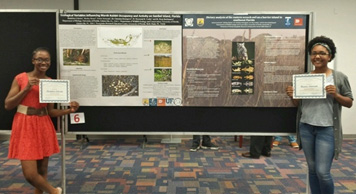 Students at the Whitney Lab volunteered to assist with oyster reef health assessments, in which they collected transect data related to biodiversity. These students also attended a poster session at a conference hosted by Flagler College. This provided them the opportunity to see how scientists communicate the results of their research and interact with a variety of professionals and other students. Connecting with a park ranger with the U.S. National Park Service regarding our road kill surveys has led to further collaboration to identify gopher tortoise road crossings within Fort Matanzas National Monument.
Students at the Whitney Lab volunteered to assist with oyster reef health assessments, in which they collected transect data related to biodiversity. These students also attended a poster session at a conference hosted by Flagler College. This provided them the opportunity to see how scientists communicate the results of their research and interact with a variety of professionals and other students. Connecting with a park ranger with the U.S. National Park Service regarding our road kill surveys has led to further collaboration to identify gopher tortoise road crossings within Fort Matanzas National Monument.
Integration, Validation, and Fusion of Small Unmanned Aircraft System Multimodal Sensor Data in Support of USGS
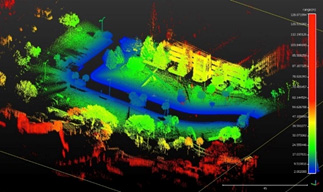
Investigator(s): Raymond R. Carthy, Peter G. Ifju, Benjamin E. Wilkinson, Scot E. Smith, and Matthew Burgess
Student(s): Travis J. Whitley, Ph.D. Student, Mechanical and Aerospace Engineering; H. Andrew Lassiter, Ph.D. Student, Geomatics Department; Chad S. Tripp, Undergraduate Student, Mechanical and Aerospace Engineering
Duration: August 15, 2016 - August 1, 2019
Small unmanned aircraft systems (sUAS) are increasingly popular tools in natural resources-based scientific studies. The University of Florida Unmanned Aircraft Systems Research Program (UFUASRP) has been tasked with integrating a light detection and ranging (LiDAR) sensor to a rotary-wing sUAS. Using LiDAR technology, the generation of high-accuracy terrain mapping and other valuable three-dimensional (3D) products are possible. Until recently, LiDAR units were too voluminous, heavy, or required excessive power to operate from sUAS. Advances in technology have mitigated most of those limitations. The objective of this study is to continue research and development of sUAS airframes and sensors, with a particular focus on integrating LiDAR with other multimodal sensor data. Calibration of the sensor suite and creating a post-processing workflow for the LiDAR data are additional objectives. Preliminary analyses indicate that the LiDAR unit will provide an extremely valuable tool for creating 3D terrain and surface maps for a host of natural resource-based sUAS applications. The desire to integrate LiDAR into civilian sUASs as a sensor option has been a request by end-users for nearly a decade. Technological advancements have overcome the physical restrictions that limited LiDAR applications on sUAS. The systematic integration of LiDAR into the available sensor options for sUAS is a landmark step in the utility of sUAS as tools for scientific data collection.
Changes in Mammal Communities Across the Greater Everglades
Investigator(s): Robert McCleery
Student(s): Jose Soto (Post Doc), Wildlife Ecology and Conservation
Duration: June 2014-August 2018
Invasive Burmese pythons (Python molurus bivittatus) may be causing declines in medium- to large-sized mammals throughout the Greater Everglades Ecosystem (GEE); however, other factors such as urbanization, habitat changes and drastic alteration in water flow may also be in fluential in structuring mammal communities. The loss of mammals in the Greater Everglades is likely causing drastic losses in the ecological functioning of the system. The cause of decline must be understood before they can be addressed by management actions. The aim of this study was to gain an understanding of how mammal communities simultaneously facing invasive predators and intensively human-altered landscapes are in fluenced by these drivers and their interactions. Python density had significant negative effects on all species except coyotes. Despite these negative effects, occurrence of some generalist species increased significantly near urban areas. At the community level, pythons had the greatest impact on species richness, while turnover was greatest along the urbanization gradient where communities were increasingly similar as distance to urbanization decreased. Python-induced changes to mammal communities may be mediated near urban development, but elsewhere in the GEE, pythons are likely causing a fundamental restructuring of the food web, declines in ecosystem function, and creating complex and unpredictable cascading effects. These effects will have clear implications for the management of wildlife and ecological function.
Experiential Learning Through Wildlife research and Management of Invasive Reptiles
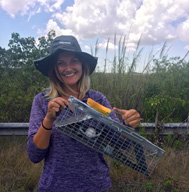
Investigator(s): Christina Romagosa
Student(s): Natalie Claunch, PhD, School of Natural Resources & Environment; also supports Diego Juarez, MS, Wildlife Ecology and Conservation
Duration: July 2014 - July 2019
University programs in wildlife ecology and/or management are crucial for the conservation and management of natural resources. Graduates from these programs most often go into academic or natural resource management agency sectors. Students must have a working knowledge of many topics, such as natural history, management, ecology, critical thinking, decision-making, effective communication, research design, as well as technological/field techniques. While some of these topics are taught in the classroom, some are best learned by experiential learning. The most effective graduates from wildlife programs are those that can link across concepts and understand how to connect research with management, regardless of whether they are on the research or management side. Florida has more nonnative species than any state, which creates unique needs for wildlife professionals. USGS & UF work with several agencies on invasive reptile research focusing on the biology, ecology, and development of control tools for these species. These projects largely depend on in-the-field work, and provide an opportunity by which interns can participate in research and management on invasive species. The multi-agency approach to these projects educates students on bridging the research-management implementation gap, while giving them field experience necessary to excel in their field. Our objectives are: a) to provide experiential learning opportunities with invasive reptiles to undergraduate and graduate students; b) provide labor through internships to attain research goals for existing USGS/UF invasive reptile research projects, (Tegu movements and demography, Python diet and Invasive reptile physiology (Claunch PhD project)) and c) increase research collaboration and opportunities between USGS and UF. To date, fifteen interns have worked/are working on the cooperative projects. These interns have gone on to other technician jobs, graduate school, or permanent positions with agencies (USGS, NPS). As nonnative species introductions increase across the United States, so will the need for wildlife ecologists that are trained to address this complex issue.
Assessing Impact of Invasive Pythons on gopher tortoises in Florida
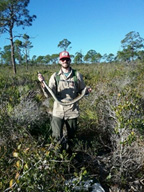
Investigator(s): Christina Romagosa
Student(s): Kodiak Hengstebeck, MS, Wildlife Ecology and Conservation
Duration: August 2015-July 2020
The Burmese python population is expanding from the core population in the southern Everglades. As pythons invade upland habitats, they are documented to also use gopher tortoise burrows. As these interactions increase, there will be as-yet-unknown effects on the gopher tortoise and the suite of burrow-commensal vertebrates. The gopher tortoise is a species of special concern in Florida, and pythons could affect their management. The study objectives are: (1) determine python occupancy of gopher tortoise burrows in the occupied range, and (2) assess burrow microhabitat as a suitable refuge for pythons north of their current range. We will also collect microhabitat data on burrows occupied and compare to burrows north of the current python range. Preliminary surveys indicate that pythons are using burrows, particularly in winter months. If burrow microclimate north of current python range is compatible, then pythons could expand their range and overwinter in tortoise burrows.
Integrating Science and Management for Optimal Prevention and Control of Aquatic Invasive species in the Everglades
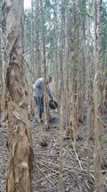
Investigator(s): Christina Romagosa
Student(s): Brad Udell, MS, Wildlife Ecology and Conservation
Duration: August 2015-September 2020
Strategic coordination of invasive species management efforts requires an understanding of the complex tradeoffs associated with the allocation of resources towards monitoring, control and research. These tradeoffs can be investigated formally within the context of a decision-theoretic framework, which can identify optimal actions based on management goals and constraints, available budgets, and the demography of the invasive population. It is critical to integrate science and management into a rigorous and organized framework to make better management decisions. Our project focuses on research that will help make more efficient decisions regarding the control and prevention of invasive species in South Florida.
Objectives to develop the decision support tools needed are for 1) optimal control of invasive species and 2) to prevent the establishment of new species by prioritizing non-native species for early detection-rapid response protocols based on the potential risks they pose to native species and habitats. To facilitate these objectives we have been working closely with regulatory agencies, we will develop decision support tools that identify the optimal allocation of resources needed to meet management objectives regarding two invasive species: tegus and melaleuca. The analytical methods developed for these case studies should help address the control of other species (e.g., Brazilian pepper). Our research will provide a framework for managing agencies to make more efficient decisions regarding the control and prevention of invasive species in South Florida.
Demographic, Movement and Habitat of the Endangered Snail Kite in Response to Operational Plans in Water Conservation Area 3A
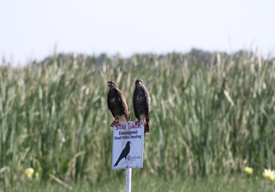
Investigator(s): Robert Fletcher
Student(s): Sarah Dudek, MS, School of Natural Resource and Environment
Duration: September 2014-December 2017
Funding Agency: Army Corps of Engineers
Our over-arching goal is to provide reliable information on population size and trends, including key demographic, habitat, and foraging information of relevance to the recovery of this species. Demographic analyses revealed that snail kite abundance drastically declined between 1999-2008, with the population approximately halving from 2000 to 2002 and again from 2006 to 2008. Each of these two periods of population decline coincided, in part, with drought conditions throughout the southern portion of the kites' range. By coupling the vital rates measured over this time period with the changes in population size (using a Life Table Response Experiment), it became apparent that the primary demographic factors contributing to this decline were changes in adult fertility (the product of young fledged per adult and juvenile survival). Because demographic parameters are heavily influenced by bird behavior, movement studies constitute the other major aspect of the research. Our objectives are to: 1) evaluate the underlying mechanisms and processes driving population dynamics, and 2) provide reliable estimates of demographic parameters and movement probabilities to upgrade management models to optimize management decisions. Snail kites were monitored by band-resight surveys in various wetlands. Nests were also monitored. Environmental data were recorded at each nest along with nest status. Once the nestlings reached an age of ~24 days, they were marked with unique bands. A total 742 active nests with known fates were detected. Of those 327 were successful. We banded 730 nestlings and 632 were observed to have fledged. Overall apparent nest success was 44 (± 2)%. Since the snail kite population is critically endangered and because adult fertility plays an overwhelming role in population growth rate, it is critical to identify and attempt to limit factors that negatively affect reproduction and juvenile survival. Long-term monitoring allows us to quantify these vital rates and link them to potential critical variables that may be limiting the population.
Identifying the Role of Hydrology and Prey for a Key Bottleneck in the Recovery of Snail Kites in the Greater Everglades
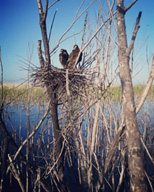
Investigator(s): Robert Fletcher
Student(s): Caroline Poli, PhD, Interdisciplinary Ecology
Duration: September 2015-May 2019
Survival of Snail Kites during the first year post-fledging is important to population growth, but monitoring data indicate that it varies among years. Young Snail Kites remain near the nest site for the first 30-60 days after fledging and the risk of mortality is highest within 45 days of fledging, thus it is likely that variability in first-year survival is driven by attributes of the natal site, including hydrology and prey availability. Fine-scale (daily, hourly) tracking information that links movement patterns of Snail Kites with hydrology and prey availability at each occupied site will allow us to develop effective management guidelines to promote first-year survival. Our objectives are to: a) quantify post-fledgling movements and first-year survival across the Greater Everglades Ecosystem; b) link movements and survival to variation in hydrology and measures of prey resources, and c) develop models that help determine key targets for water management in the Greater Everglades Ecosystem. We plan to estimate movement trajectories using hidden Markov models, and to predict switching of behavioral states using covariates related to snail density (measured through in-situ sampling) and hydrology (extracted from online databases such as EDEN). Preliminary data confirm that birds spend the first 30-60 days post-fledging within 1 km of the nest site. Birds that dispersed from the nest site made looping foray flights lasting 1-5 days each, then returned to the original nest site. Analysis of movement trajectories in relation to hydrology and prey is ongoing. Models will be disseminated to agencies and managers to help determine key targets for water management. We will emphasize identifying potential thresholds in hydrology and snail metrics that can explain changes in movement behaviors.
Using Models to Assess Gulf Sturgeon Population Viability
Investigator(s): Bill Pine and Rob Ahrens
Student(s): Merrill Rudd, PhD, University of Washington; Krystan Wilkinson, PhD, University of FL
Duration: August 2016-June 2018
Gulf sturgeon, a large anadromous fish species currently listed as "threatened" under the Endangered Species Act are of conservation concern in the Gulf of Mexico because of their long-live span and slow population recovery rate. We are working with NOAA and USFWS resource managers to develop two tools to inform management actions designed to promote Gulf sturgeon population recovery.
We are designing two population models for use in prioritizing management actions for Gulf sturgeon. The first is a stochastic population viability model (PVA) that allows managers to assess extinction risk for Gulf sturgeon with very small population sizes that have been subjected to frequent high mortality events including oil spills and large hurricanes. The second model is an age-structured population model that is useful for evaluation tradeoffs in management actions directed at different life-history stages. These models for Gulf sturgeon are based on earlier published efforts for similar species. The PVA model is based on an approach described in Pine et al. (2013) based on a series of workshops with USGS and USFWS cooperators. The age-structured model follows a common framework used for many fish populations and was originally developed for commercial fisheries applications. We have completed model development are currently working with USFWS and NOAA colleagues to develop a workshop at the upcoming Gulf sturgeon working group meeting to present the models and assess a variety of extinction risk and population recovery scenarios as a planning exercise. Gulf sturgeon resource managers are currently developing plans for new management actions such as improved access to spawning grounds, spawning habitat enhancement, or efforts to reduce adult mortality using funds from the Natural Resource Damage Assessment. These models are helping to inform those planning efforts.
Evaluating Effectiveness of Using an Integrated Outreach and Trapping Program to Remove Invasive Wildlife in South Florida
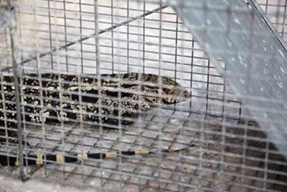
Investigator(s): Frank J. Mazzotti
Student(s): Jenna Cole, Sarah Cooke
Duration: August 2016-September 2019
Gold and Argentine black and white tegus (termed tegus) are established in southwestern Miami-Dade County. The core of their distribution is south of Florida City and west of Homestead. Tegus have been captured within Everglades National Park (ENP), the Southern Glades Wildlife and Environmental Area, Florida Power and Light (FPL) Turkey Point Power Plant (TP) and the FPL mitigation area, and in scattered locations throughout South Dade agricultural area. Camera and live trapping have discovered tegus dispersing in all directions towards the boundaries of ENP, TP, Bird Drive Basin, and Crocodile Lake National Wildlife Refuge (CLNWR). Major gaps in knowledge of tegus include; what is their distribution, abundance, and occupancy in the South Dade agricultural area and how effective is trapping at removing tegus? This knowledge could be applied to develop protocols of where, when, and how to detect and remove tegus as well as how to regionally monitor and evaluate responses of tegus to removal efforts. The objectives of this study are to design and implement a surveillance and removal program to characterize distribution and abundance of tegus in southwestern Miami-Dade County; design, implement and manage a trapping program specifically for gold tegus in southwestern Miami-Dade County; and provide science and outreach support to disseminate results of these activities. Tegu surveillance will include active and passive components such as camera and live trapping, visual surveys, and outreach to landowners, agricultural workers, local herpetologists, and government and utility employees. Camera and live traps will be placed at or near locations where tegus have been sighted or suspected tegu habitat. Visual surveys of these locations will be conducted while traps are being checked. Results from the surveillance project will be applied to locate traps to remove tegus and to monitor the spread of tegus.

